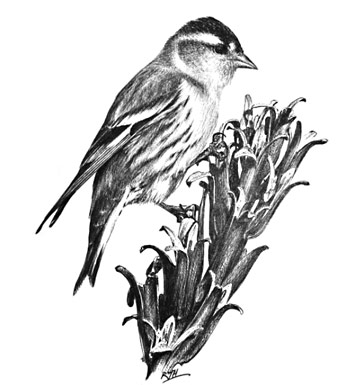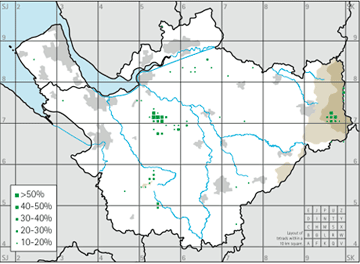
Siskin © Ren Hathway

Coniferous woodland land cover.
The entire life cycle of this woodland finch is dictated by tree seeds. When seeds are abundant, Siskins can breed as early as February; in other years they delay until April or May. Early chicks are fed on the seeds of opening Spruce Picea cones, whereas later broods are reared on seeds from pine cones, with other seeds and insects. Their population may well vary considerably from year to year, as they usually rear two broods in years of early breeding, and only one in other years.
Their breeding range has expanded greatly in Britain (BTO Atlas), attributed to maturing of conifer forests, and this expansion has included Cheshire. Breeding was first proven in Delamere Forest in 1962 and 1964, with a poorly-documented record in Wirral in 1976, but there were no breeding records during our First Atlas in 1978-84. The annual county bird reports show that observers mostly concentrate on any large flocks, but they contain sporadic records of birds in ‘summer’ with breeding proven in 1990, when a pair were feeding young in Lyme Park on 4 June. From then on, records that would merit a breeding status code came from a gradually increasing number of sites, especially Macclesfield Forest, Lyme Park and Alderley Park, with the annual county reports noting birds singing in most years, seen carrying nesting material twice and ‘breeding suspected’ once. There was no more confirmation of breeding until this Atlas started in 2004, however, but this is a tricky species in which to prove breeding and it is difficult to establish its true status in the county. Many males sing on passage, from late winter onwards, sometimes even performing their ‘butterfly’ display flight on bright spring mornings, and it can be problematical to separate locally breeding birds from Siskins on their way to breed in Scotland; their wide variability in timing of breeding from year to year further complicates this.
Although most submitted habitat codes were broadleaved or mixed woodland, the Atlas map shows a clear correlation with coniferous woodland, with occupied tetrads in Delamere and Macclesfield Forests, with another group of tetrads around Wilmslow and a few scattered records elsewhere. Four tetrads furnished proof of breeding, three of them with observers in gardens seeing recently-fledged juveniles being fed by their parents, two of them in May 2004 and the third in 2006. The fourth record came in 2005 when Sheila Blamire had the good fortune to be able to stand on a slope above Wildboarclough (SJ96U) and look down into a nest in the top of a small pine only 3 or 4 m tall, where she saw a nest with the female Siskin regurgitating food for the chicks whilst the male called nearby.
Sponsored by David Simmons

